
Poly(propylene glycol)
- Product NamePoly(propylene glycol)
- CAS25322-69-4
- CBNumberCB4123367
- MFCH4
- MW16.04246
- EINECS500-039-8
- MDL NumberMFCD00084446
- MOL File25322-69-4.mol
Chemical Properties
| Melting point | -40 °C |
| Boiling point | >300 °C |
| Density | 1.01 g/mL at 20 °C |
| vapor density | >1 (vs air) |
| Pour Point | -26 |
| Pour Point | -45 |
| vapor pressure | <0.01 mm Hg ( 20 °C) |
| refractive index | n |
| Flash point | 230 °C |
| solubility | H2O: <0.01 % (w/w) at 25 °C |
| form | Viscous Liquid |
| Specific Gravity | 1.005 |
| color | White to light gray |
| Viscosity | 105mm2/s |
| Water Solubility | PRACTICALLY INSOLUBLE |
| FreezingPoint | -25 |
| FreezingPoint | -40 |
| Stability | Stable. Substances to be avoided include strong oxidizing agents. |
Safety
| Symbol(GHS) |

|
|||||||||
| Signal word | Warning | |||||||||
| Hazard statements | H302 | |||||||||
| Precautionary statements | P264-P270-P301+P312-P330-P501 | |||||||||
| Safety Statements | 24/25 | |||||||||
| WGK Germany | 1 | |||||||||
| RTECS | TR5250000 | |||||||||
| TSCA | Yes | |||||||||
| HS Code | 39072090 | |||||||||
| Hazardous Substances Data | 25322-69-4(Hazardous Substances Data) | |||||||||
| NFPA 704: |
|





